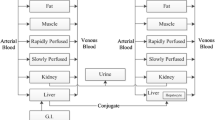Summary
Most drugs undergo two or more concurrent biotransformation reactions. If these can compensate for each other, pharmacokinetic data concerned solely with the parent drug may hide, rather than reveal, the variability of specific reactions. Hence, there is room for the development of testing procedures, suitable for defining specific drug-metabolizing reactions, and sufficiently simple to allow the testing of numerous subjects or populations. We scrutinized the effects of reducing the collection of urine samples on the reliability of metabolic rate constants, using amobarbital as a model drug. Eight healthy subjects ingested amobarbital, and the rates of urinary excretion of its metabolites were followed for 5 days. Rate constants could be accurately determined using only two 12-h night urines, the second and fifth day after drug intake. Supplementary results obtained by studying additional groups of subjects suggested that a shorter time for urine collection than a 12-h period led to erroneous estimates of the rate constants of metabolite formation. This could be explained partly by a dependence of amobarbital metabolite excretion on urine flow if the flow rates are less than 40 ml/h.
Similar content being viewed by others
References
Kalow W, Tang BK, Kadar D, Inaba T (1978) Distinctive patterns of amobarbital metabolites. Clin Pharmacol Ther 24:576–582
Kalow W, Kadar D, Inaba T, Tang BK (1977) A case of deficiency of N-hydroxylation of amobarbital. Clin Pharmacol Ther 21:530–535
Kalow W, Tang BK, Kadar D, Endrenyi L, Chan FY (1979) A method for studying drug metabolism in populations: Racial differences in amobarbital metabolism. Clin Pharmacol Ther 26:766–776
Idle JR, Smith RL (1979) Polymorphisms of oxidation at carbon centers of drugs and their clinical significance. Drug Metab Rev 9:301–317
Inaba T, Otton V, Kalow W (1980) Deficient metabolism of debrisoquine and sparteine. Clin Pharmacol Ther 27:547–549
Baldeo WC, Gilbert JNT, Powell JW (1979) A multi-dose study on the human metabolism of amylobarbitone. Xenobiotica 9:205–208
Author information
Authors and Affiliations
Rights and permissions
About this article
Cite this article
Tang, B.K., Kalow, W., Endrenyi, L. et al. An assessment of short-cut procedures for studying drug metabolism in vivo using amobarbital as a model drug. Eur J Clin Pharmacol 22, 229–233 (1982). https://doi.org/10.1007/BF00545220
Received:
Accepted:
Issue Date:
DOI: https://doi.org/10.1007/BF00545220




